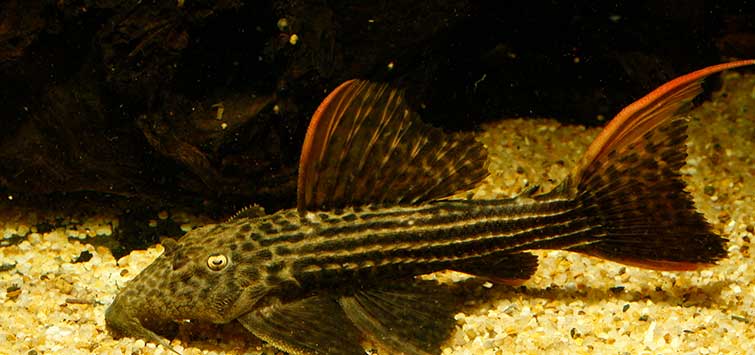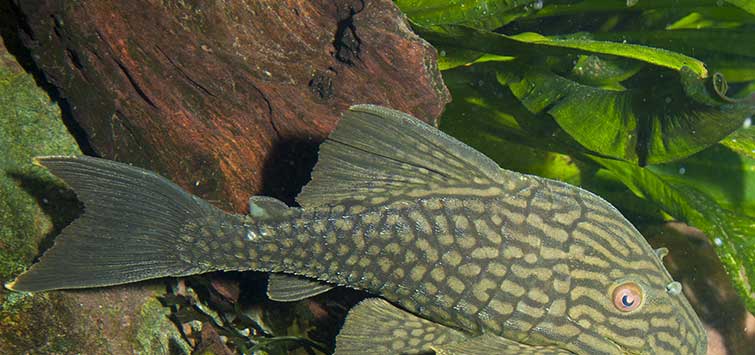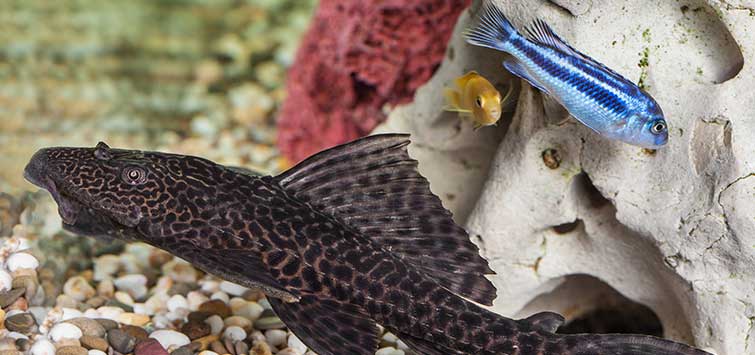Breeding Cactus Plecos
Author: Daniel Konn-Vetterlein
Cactus plecos are extremely colorful, but they have a reputation for being hard to breed. A catfish enthusiast relates how he achieved breeding success with these prickly named plecos.
Rare Beauties
The cactus plecos, species of the genus Pseudacanthicus, are among the most attractive and most sought-after of the big aquarium catfish. Most of them grow quite large, and their successful keeping and breeding had largely eluded hobbyists in the past. In more recent times, however, we have more knowledge about the proper care of these fishes, and how to breed them.
We currently know of about 35 different cactus plecos, including real species and varieties from different localities. Among these, only five have been described: P. serratus (Valenciennes, 1840), P. leopardus (Fowler, 1914), P. fordii (GÜnther, 1868), P. spinosus (Castelnau, 1855) and P. histrix (Valenciennes, 1840). Most originate from Brazil, where they live in big rivers like Rio XingÚ and Rio Tocantins. P. fordii and P. serratus are known only from Suriname and Guyana, and both species are almost unknown in the hobby. From other countries, we know of L452 so far, which is from Peru.
Caring for Cactus Plecos
How can you ensure your plecos will do well? First, it is important to keep in mind that some species tend to be quite aggressive towards each other and other loricariid species. The tank has to offer several hiding places to prevent the worst-case scenario: that a fish dies as a result of stress caused by others or in a direct fight with another specimen. Depending on the chosen species, the tank should measure at least 100 cm (40 inches) in length and 40 to 50 cm (15 to 20 inches) in depth. The height is not that important because plecos are mostly bottom-oriented.
Tank Setup
The tank setup is very important too. Caves, driftwood hiding places, and stones that have large openings help make plecos feel secure. They don’t need plants. In fact, almost no plecos need plants in the tank. But if there are no plants, there is also no supplemental oxygen being produced, so make sure the filter is working well. You might also want to install a second pump or air pump to increase the level of oxygen in the water.
Water Temperature
Most Pseudacanthicus species inhabit warm water, so they need temperatures above 27°C (80°F) to feel comfortable and grow well. Their nutrition consists of snails, insects, dead fish, and comparable organic stuff. This is what they need in captivity; they won’t get by on cucumber slices like many people still believe.
Breeding
These plecos have been kept in captivity for quite a long time, but breeding successes were uncommon until a few years ago. One main reason for this is that most people kept only one specimen. Some even collected these fishes like stamps. The interest in breeding cactus plecos was low, and they were mostly seen as status symbols for their keepers. Additionally, big plecos like Pseudacanthicus were rumored to be impossible to breed in captivity, so nobody really tried.
All this suddenly changed when the first serious breeding attempts succeeded. More and more keepers concentrated on the genus and tried to keep groups, hoping to find a pair that might breed. Due to this effort and some amount of luck, several species have been bred in the past few years.
The First Steps for Successful Breeding
In most species, it is possible to distinguish the genders when they reach about 15 cm (6 inches). The males will develop longer pectoral and ventral fins, and their pectoral spines will be thicker than those of the females. Furthermore, the heads of male specimens look bulky and chiseled, while females’ heads are more pointed.
Aquarium Setup
If the setup is adequate for these plecos, and if you are lucky enough to have a sexed pair, they might soon start breeding. You can go on to keep them in a group, or you can move the pair to a prepared tank without any other fish. A tank like this has several benefits: First, they don’t have to invest their energy in territorial fights with other fish; second, they can feed in peace and will be sure to get enough to eat; third, the water parameters can be completely changed to their favor; and fourth, if they spawn and the juveniles get out of the cave, they will not be eaten by predator fish.
Nutrition
However, you will have to get the fish into the best possible condition. The most important factor is nutrition, because without excellent protein-rich food, the female is not able to develop eggs. Feed them mostly frozen food and meaty tablets. Don’t just give them vegetables and algae wafers; they might eat these items, but it will not bring them into breeding condition.
You can tell when the female is full of eggs by comparing her belly to the male’s belly. It will be much wider, and the male will look a lot more slender in comparison.
Water Changes
This is the right time to start with some stimulating water changes. Experience has shown that Pseudacanthicus react to water changes using soft and slightly acid water. If you have the ability to get clean rain water, you should try to collect this and use it for the breeding tank. After adding this water to the plecos’ tank, they will hopefully start getting interested in each other. The water should be warm (about 27° to 32°C [80° to 90°F]), soft, and neutral to slightly acid.
Caves
People keep asking me about the perfect cave for plecos, which color it is supposed to be, and which material the fishes prefer. I can tell you that color doesn’t matter, but the surface of the cave’s interior should be rough to provide a good grip for the clutch. It should be about 5 cm (2 inches) longer than the male’s total length and wide enough for the male to get in with both pectoral fins half-extended.
While the male is staying in the cave, the female tries to get in there as well. The proceedings then depend on the character of both specimens. Usually it takes a few hours for the female to enter the cave, but sometimes she doesn’t get in even after a few days. The female has to be in front of the male to lay her eggs along the top of the cave, and the male will fertilize the eggs just as they are released.
Some females stay in the cave for a few days before they lay the eggs. But not every spawning attempt is successful; from time to time, both specimens spend days in the cave and nothing happens. Often these are fish that have never bred before; they are still learning, and the second attempt normally succeeds. After the female leaves the cave, the male starts fanning with his fins. By doing this, he helps oxygenate the cave and keeps the eggs alive.
Prepare for Juveniles
Adult females can produce about 500 eggs, which is a huge mass of eggs—and potential juveniles. The raising of so many young fish can cause problems considering the space that is needed.
Depending on the temperature, they hatch after six to seven days. The larvae need about five days to use up their yolk sac. During this time, the male takes care of them and does not release them from the cave. Afterwards, the juveniles spread into the tank and grow up rapidly.
Another option is to shake the cave outside of the water to get the eggs or larvae out and then move them into a separate tank. They can be fed better and a few times a day in this special tank. Young Pseudacanthicus grow very quickly during the first months and become more stable.
A lot of breeders have had problems at 3 cm (1 inch) in size. Juveniles often start dying at this age. The reason is that most tanks are overcrowded and the young plecos don’t have enough space to hide from each other. They get stressed rapidly, and apparently they are very prone to stress at this age.
Another fact that has to be considered is the concentration of bacteria, which is very high in small tanks with so many fishes. So, make sure the aquarium is big enough for such a quantity of fish, that the water parameters are good, and they are fed several times a day. Then raising them will be easy, and your cactus plecos will grow quickly, soon attaining a large size.

.png?h=595&iar=0&w=2781&hash=5FD5E69473BCC22199FBFA2FB71B6033)



